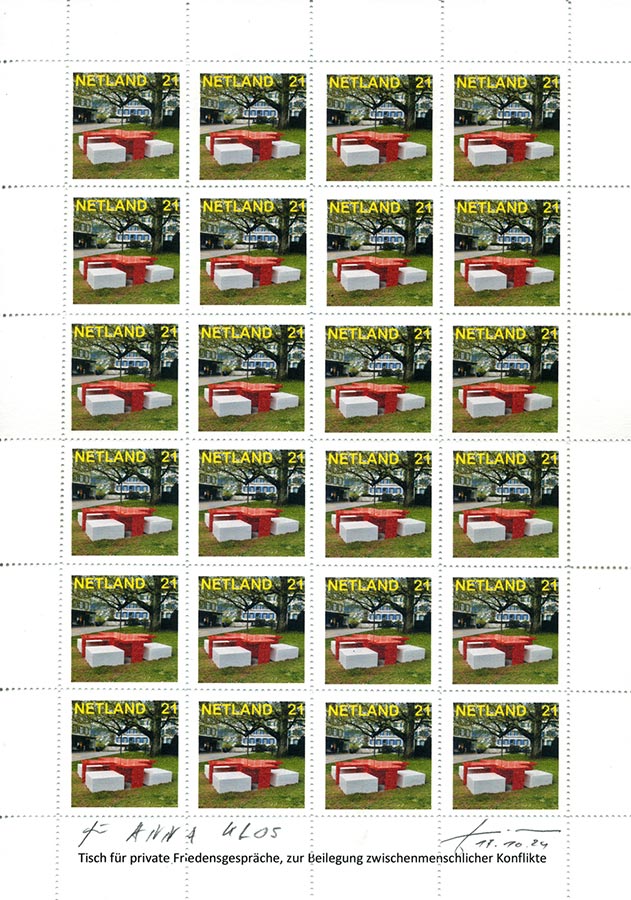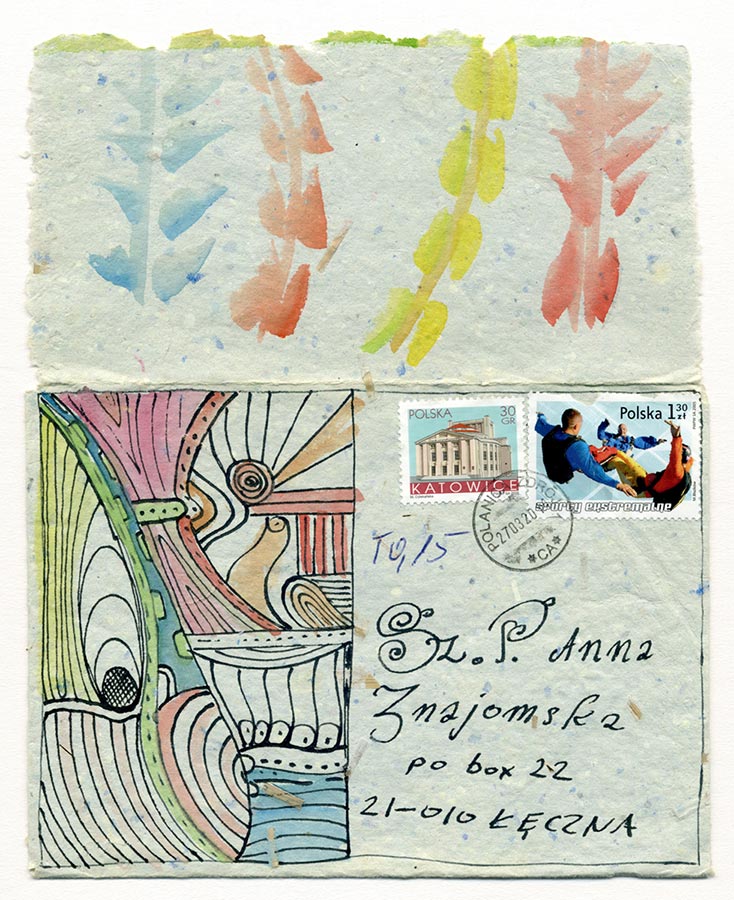Mail Art Continuum – International Mail Art Exhibition in Warsaw – March 30, 2023 – April 30, 2023
Exhibition curators: Anna Kłos (Retroavangarda) and Dariusz Mlącki (Korekta Gallery)
Korekta Gallery: Mazowiecka 11A, 00-052 Warsaw.
Participants: Ballabeni / Baroni / Bealy / Bellini / Beuys /Borkowski / Brandtner / Cohen / De Decker / Gillen / H. R. Fricker / Held Jr / Hemmerdinger / Kłos / Krochmalski / Kuntner / Luigetti / Mlącki / Nielsen / Pallara / Radke / Roussopoulos / Sousa / Tress / Welch / Znajomski
Mail Art is a form of art that goes beyond traditional boundaries and emphasizes freedom of expression and artistic creativity.
From March 30th to April 30th, 2023, in the very center of Warsaw, at the Korekta Gallery, you can see an international mail art exhibition. It features 26 artists from 10 countries. Among them are veterans of mail art – absorbed by this trend for over 40 years. There are also artists who practice other fields of art such as painting, drawing, or graphic design on a daily basis, for whom mail art was a short but important episode in their creativity. The exhibition includes over 80 diverse objects, such as artistic postage stamp projects, art zines, postcards, envelopes, and artistic stamp projects. The works come in various formats and from different years. They are connected by one thing: non-commercial, avant-garde-inspired character.
Let’s take a closer look at the artists invited to the exhibition. We have been collaborating with several of them for years, as they participated in the international collage exhibition organized by Retroavangarda and are part of the Retroavangarda’s Gallery of Friends. I’m talking about Willam Hemmerdinger, Allan Bealy, Pere Sousa, and Kevin Brandtner.
William Hemmerdinger has created three small-sized collages specifically for this exhibition. They are designed in the artist’s characteristic style and consist of elements from old, private correspondence such as letters, envelopes, American stamps, and postage stamps that were in circulation at the time. Hemmerdinger’s works show clear inspirations from Dadaism, especially the art of Kurt Schwitters. A significant element of these collages is typography, and just like in Schwitters’ works, the titles of the pieces are the most visible inscriptions from old documents.
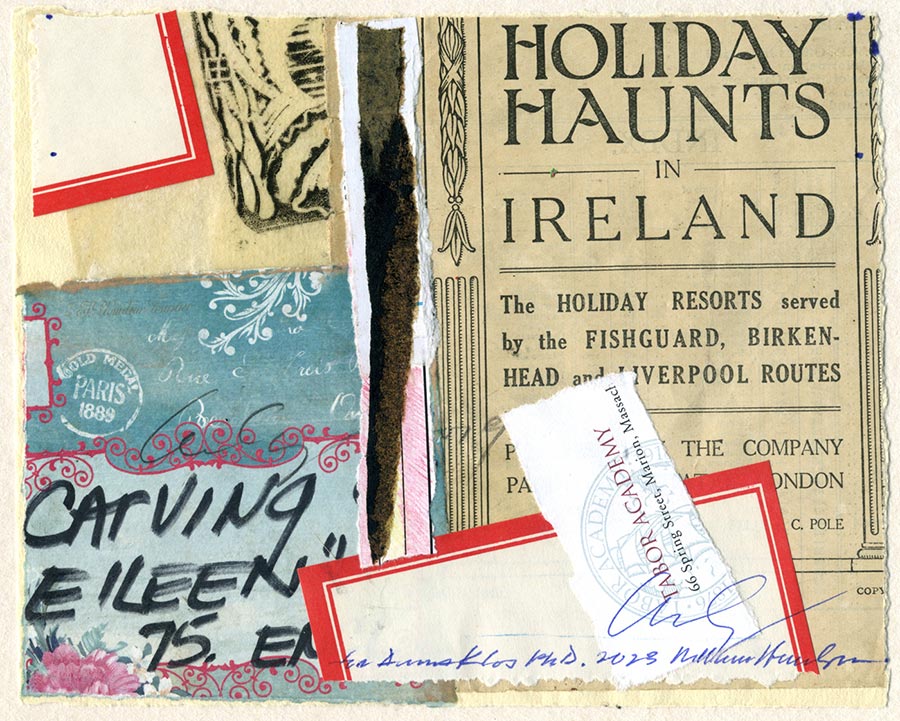
Allan Bealy also specializes in collage art. He sent two handmade postcards and a small block of artist stamps to the mail art exhibition. Bealy creates his collages in series and sends them by traditional mail to his artist friends. His works stand out for their sophisticated color scheme and composition. As an experienced collagist and former graphic designer, Bealy has honed his craft to perfection. Important elements of his postcards include stamps, dedications, and signatures.

Pere Sousa’s work, on the other hand, is very diverse. Since the 1990s, the artist has been publishing various artistic publications and carrying out mail-art projects, as well as creating visual poetry as part of his own Merz Mail Factory. This is his own project inspired by Schwitters’ MERZ. Sousa has created hundreds of collages and photomontages. From 1994 to 1999, he edited the art zine P.O.BOX, two original covers of which from the 1990s were presented at our exhibition.

Austrian Kevin Geronimo Brandtner is both an artist and organizer of mail art projects. He passionately realizes his ideas and thus contributes to the development of global mail art. He sent several very intriguing objects to our exhibition, including a black and white photograph depicting the interior of an abandoned house. In Brandtner’s photographed room, you can see a fireplace with ash remaining inside. And that same ash was poured by the artist into a small plastic bag and attached to the photograph. All of Brandtner’s mail art projects have this philosophical and conceptual character, provoking the viewer to reflect on their existence and transience.
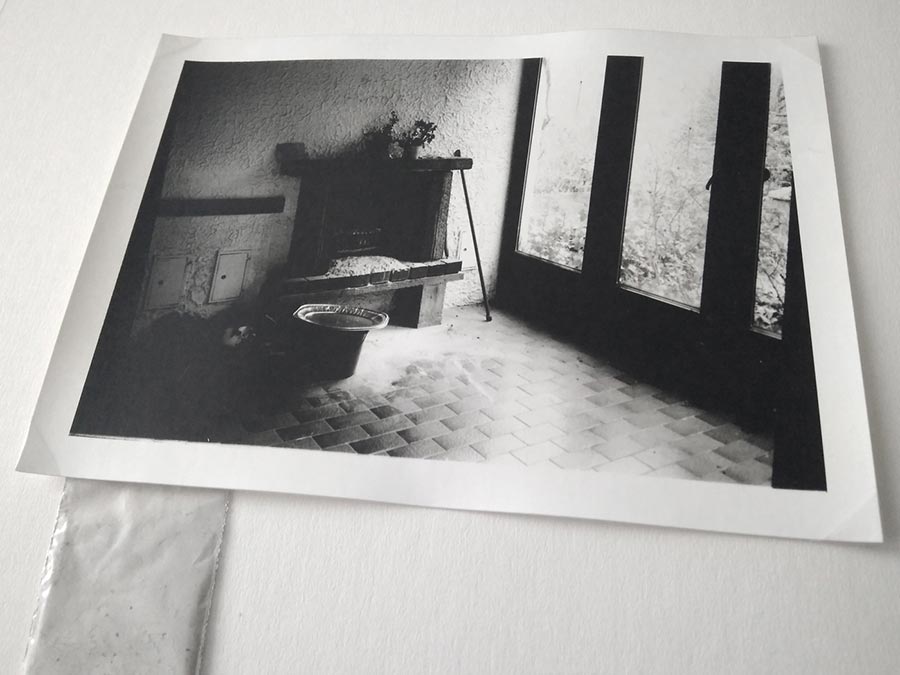
The exhibition in Warsaw also features several more painterly works, which are somewhat less typical of mail art. These include projects by Piotr Krochmalski, Dariusz Mlącki, and in a sense, Kevin Gillen and Cristiano Pallara.
Cristiano Pallara attended the School of Painting and Set Design at the Academy of Fine Arts in Lecce, Italy. His creative interests are not only focused on painting, but also on video and music projects. The exhibition features two postcards by Pallara. One of them depicts human figures moving away, creating dark rhythms against a greenish horizon. The other is almost entirely abstract and was created by layering semi-transparent tape over an image. In Pallara’s work, groups of people, architectural elements, and landscapes often appear, but they always create rhythm, connecting his work to music.
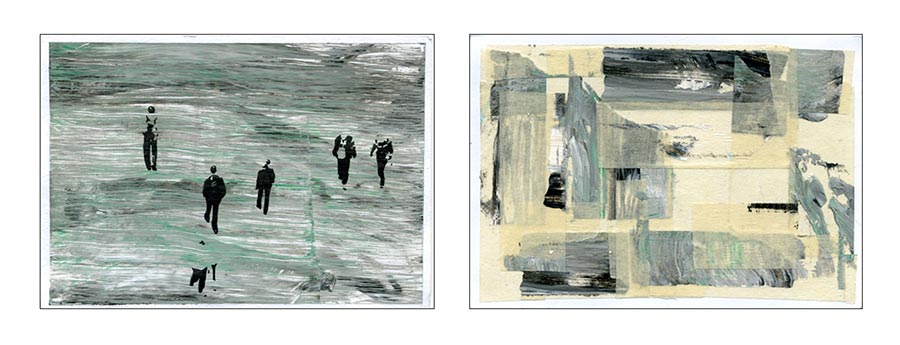
Piotr Krochmalski specializes in large-format drawing. I still remember his several-meter-long drawing on packing paper that hung in the European Academy of Arts where I studied, and where Piotr Krochmalski was then teaching advertising art. For the purposes of our exhibition, Piotr prepared a slightly smaller work in the format of 100 x 70 cm, although for a mail art exhibition, it is still a gigantic work! It depicts two French postage stamps: one with a portrait of Van Gogh and the other with his severed ear. The drawing is titled ‘Letter from Arles’. As we know, Van Gogh corresponded with his brother Theo for many years, and about 600 letters sent by Van Gogh have survived, which are the main source of knowledge about the artist. Krochmalski’s work draws attention to the important role these letters played. Of course, they were not mail art in the sense of the contemporary movement, although they were sent by the artist. Krochmalski’s work is not mail art either, but it is undoubtedly an intriguing accent of the entire exhibition that provokes reflection on the definition of mail art and its genesis. As for the genesis of the discussed topic, it is said that the first mail art in history was delivered to Caesar wrapped in Cleopatra’s carpet.

Dariusz Mlącki (an artist, educator, and owner of Galeria Korekta) has been painting envelopes for years. Envelopes made of paper, flowers, sky, feathers, open, closed – they conceal a secret inside while also being an illusion. The well-painted envelopes are also a testament to his craftsmanship. Although primarily a painter, in the 1990s Mlącki created a series of paper envelopes that he sent through traditional mail to friends and art curators.

Kevin Gillen from the UK has been actively involved in mail art for many years. The exhibition features two colorful prints in Gillen’s distinctive style, which is somewhat reminiscent of pop art and also of the work of Francis Picabia. Both works are from recent years. There is also an interesting envelope with a hand-painted B2 bomber – invisible to radar. It is the same model of bomber that appeared in the skies during the war in Yugoslavia and on the cover of Cieślewicz’s cult art-zine titled ‘Kamikaze’. Like Cieślewicz, Gillen’s project is a protest against war. This is a very relevant topic, especially in Poland, which borders Ukraine.

On the exhibition, there are also more anti-war mail art projects. I am referring to the artistic stamps by Pere Sousa, as well as the work of Danish artist Mogens Otto Nielsen. Nielsen is an icon of mail art. As it happened, his last shipment arrived just in time for this exhibition. Nielsen was a prominent creator, highly engaged in projects with pacifist and ecological character. Apart from mail art, he practiced happening, performance, and environmental art. His works were collected in an album that we presented during the vernissage. Among several Nielsen’s works on the exhibition, special attention is drawn to ‘Stamp Action for Peace’ – a photo from 1983 of an artistic action for peace.

The exhibition also features a sheet of artistic stamps from February 2022 titled ‘Stop Putin’s War’ designed by Chuck Welch – an artist who needs no introduction. Chuck Welch (a.k.a. CrackerJack Kid) is an icon of the global mail art movement, an educator, and the author of numerous texts on the history of this artistic movement in the United States and beyond. From 1980 to 1995, Welch collaborated and often corresponded with Ray Johnson, the ‘father of mail art’ and the founder of the New York Correspondence School. While preparing for this exhibition, I went through a book by Piotr Rypson (former director of the National Museum in Warsaw). This publication was issued in 1985 in an edition of 500 copies, and it contains texts written by three artists presented in our current exhibition, including Chuck Welch’s ‘About Mail Art’. This is, therefore, 40 years of a wonderful history.
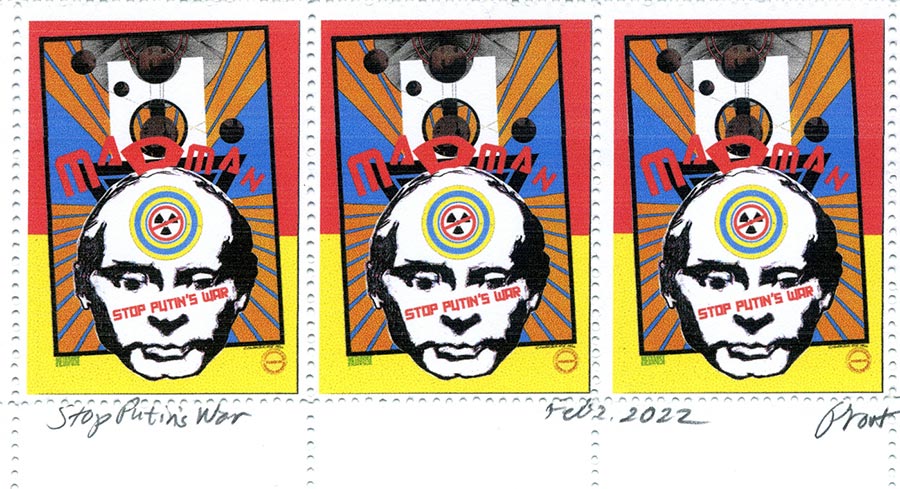
John Held is also a veteran of mail art from the USA. He is a very active creator who has realized many wonderful projects and has written many valuable texts and books on the subject of mail art. Especially for the exhibition in Warsaw, he sent me his latest series of perforated postage stamps called ‘California’.

Adam Roussopoulos is a younger generation mail artist who, as he claims, learned about mail art from his American masters. Today, he publishes artistic postage stamps and creates stamps with the portraits of other artists. His designs stand out for their ideas and high design level. Roussopoulos has mastered his craft well and is one of the most active contemporary creators of mail art. Therefore, in my opinion, he has a significant influence on the development of this movement in its traditional and avant-garde form.

One of the most recognizable figures in the mail art community is Japanese artist Ryosuke Cohen. His project called Brain Cell is unique and has been consistently carried out since 1985. Brain Cell is a networked art project in which individual artists design stamps, stickers, drawings, or other small graphics. They are sent by traditional mail to Cohen, who puts them together and prints them as part of each ‘cell’ – a kind of board. He prints 150 copies in A3 format using a silk screen printing technique called Cyclostyle (a technique that is currently discontinued). Each participant receives a Brain Cell print by mail along with a list of documentation of participants from around the world. Cohen named his project ‘Brain Cell’ because, as he himself says, the structure of the brain seen through a microscope looks like a Mail Art network diagram. The exhibition features a Brain Cell board from 2016 from Robert Znajomski’s collection.

Italian artists also have a strong representation in the exhibition. Most of them are also associated with visual poetry. One of the most deserving mail art creators in Italy is Vittore Baroni. Since the mid-1970s, he has been one of the most active promoters of mail art. He has written or edited various books on the aspects of ‘network cultures’ that preceded the Internet, including a guide to mail art called Arte Postale – Guida al network della corrispondenza creativa (AAA Edizioni, Bertiolo, 1997). He has organized many exhibitions, events, publications, and collective projects in the field of mail art, audio art, visual poetry, underground comics, and street art. He has published and distributed 100 issues of his art zine Arte Postale! (1979-2009) and was the originator of groundbreaking network projects such as the modular TRAX system (1981-1987). The exhibition in Warsaw features, among other things, artistic stamps by Baroni, cards, various types of prints, and an example of a typographic collage with hand-glued letters. This collage is a bridge between typical mail art and visual poetry.

Another Italian artist who has developed a distinctive style based on typography is Serse Luigetti. He has participated in hundreds of mail art exhibitions over the past 40 years. Luigetti creates sheets of stamps, postcards, and art zines. His designs consist of letters, typographic elements, and are based on repetitions creating an abstract rhythm. The colors are usually contrasting, with black, white, and red adding dynamism and expressiveness to his projects.

Lancillotto Bellini, also known as the ‘Portrait Man’ in the mail art community, creates works in a completely different style, but also highly recognizable. For years, Bellini has been creating a series of postcards and stamps with portraits of famous artists. The vibrant colors and simplified form give them a character of a sign, symbol, or icon. The postcards are accompanied by a series title, which is also a symbolic message to the recipients, as well as the inscription ‘ORIGINAL’ and a stamp in the form of the artist’s monogram. The exhibition in Warsaw presents six of Bellini’s postcards from two series: ‘Mail art for a better world’ and ‘Mail art saves our brains.’

Franco Ballabeni, an Italian artist who has been involved in mail art and visual poetry since 1984, is also taking part in the exhibition. We present a postcard created by him documenting a performance from 2019 in Venice.
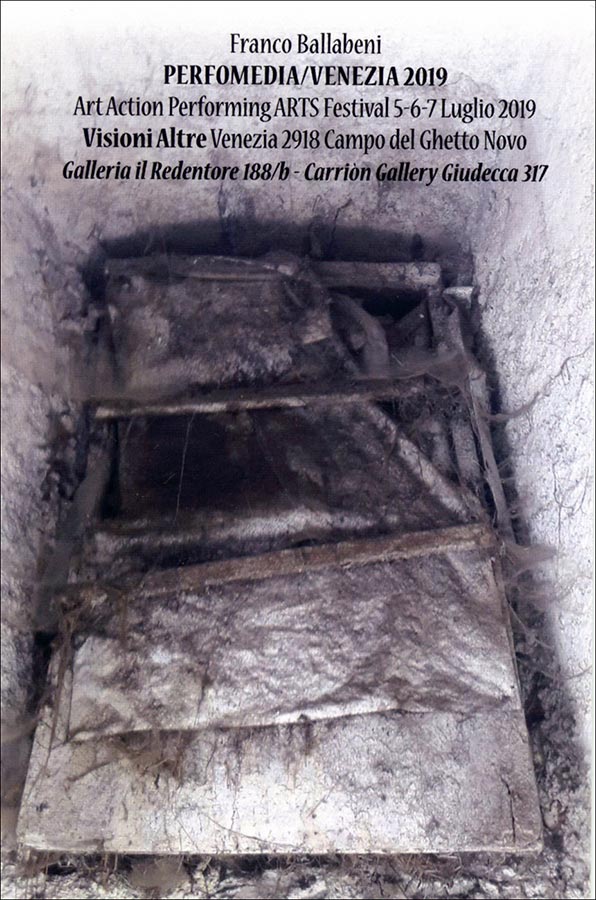
Geert de Decker began his adventure with mail art in the 1980s. Over the years of artistic and curatorial activity, he has collected a huge collection of mail art, which was ultimately accepted by the Reina Sofia Centre of Arts National Museum in Madrid and has been in its archives ever since. For the exhibition in Warsaw, Decker sent several artistic prints containing colorful stamps depicting his most characteristic projects.

H. R. Fricker, who lives in Switzerland, sent two works in 2021: a typical envelope with the inscription ‘Stoneland’ covered with stamps of his own design, and a sheet of stamps featuring a project of a table in the shape of a Swiss cross. It is a ‘Table for private peaceful conversations to solve interpersonal conflicts.’ In 1981, H. R. Fricker founded the ‘Office for Artistic Activities in the Country’ in Trogen in Appenzell Ausserrhoden and has since become one of the most active artists on the global mail art scene. Fricker is the author of the famous slogan: ‘Mail art is not fine art. It is the artist who is fine,’ which he often puts on his envelopes.
The work of Andreas Kuntner, who comes from Salzburg, is very consistent and stands out for its high level of graphic design. He presents his artistic stamps related to his collaboration with other artists at the exhibition. These collaborations are an expression of his motto ‘Hirschen aller Länder vereinigt Euch!’ / ‘Deer of all countries unite!’ When a huge number of post offices were closed down in Austria, Kuntner founded his own artistic post office, which operates under the following names: ‘Post Fluxus Office,’ ‘Luxus Post Office,’ ‘Almbach Post’ (= Alp Creek Post), and ‘Mobiles Wald- Wiesen- & Feldpostamt’ (= Mobile Forest Grassland & Field Post Office).
Kuntner often sends empty envelopes with the stamp ‘Nothing Inside,’ and in this case, the envelope itself is a mail art work of art.

‘An interesting work was contributed to the exhibition by Marek Radke, a Polish artist who emigrated to Germany years ago. The diptych consists of two envelopes referring to the history of the GDR and FRG. The work was created in 1989 shortly before the reunification of Germany. It consists of two parts: a piece made and sent from West Berlin, and a piece made and sent from East Berlin. It was sent to the now-defunct Carillon gallery in Paderborn. The relief on both envelopes is a multiplication of the word ‘Ordnung’, which is most often associated with Germany by foreigners. The postage stamps relate to the 40 years of the GDR and FRG. Standard envelopes available to residents of both parts of Berlin were used in the works.
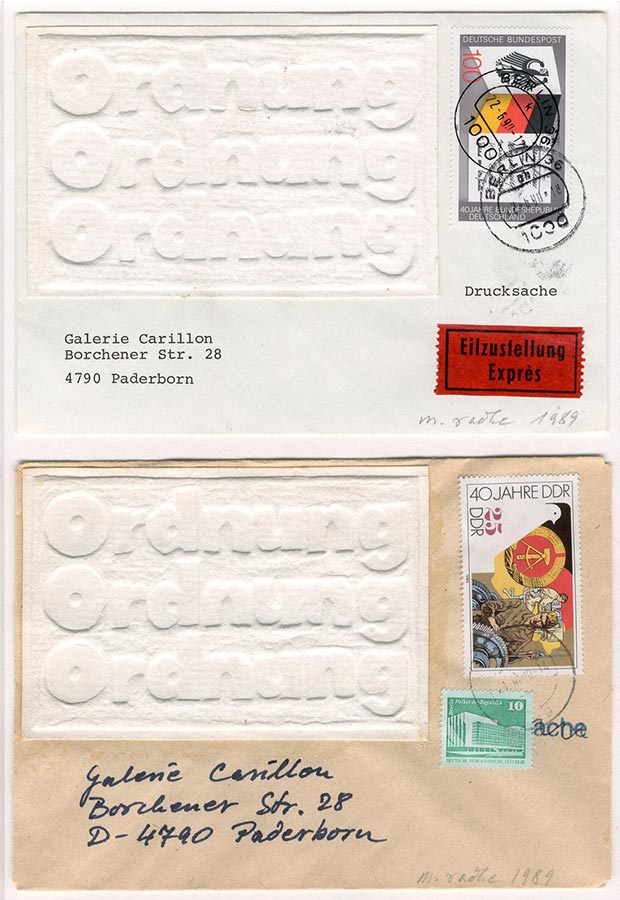
Horst Tress also refers to the history of Germany. As he writes: ‘When Germany was still a divided country, we were in close contact with mail artists from the former GDR. We often exchanged letters in sealed envelopes, but we also had personal meetings. West German diplomats, who were not subject to border controls, greatly helped to increase the exchange. When we managed to smuggle the Documenta catalog across the border, we could be sure that hundreds of colleagues knew about it and that it passed from hand to hand. Exhibitions that would not have been officially approved were organized for small groups in private homes.’ Horst Tress sent a metal box with the inscription ‘My Fluxpostphotos are ideas & stories’ to the exhibition, containing tiny, author’s photographs under the common name of the series ‘Rolling photos by Horst Tress.’ The photographs refer to everyday life, interpersonal contacts, and social problems. Tress’s projects bring to mind good social posters (so-called ideational posters), as well as surrealist ideas by Rene Magritte and beautiful photographs by Man Ray. They also show direct references to Fluxus and the work of Joseph Beuys, whom Tress regards as his mentor.
It is worth mentioning that most contemporary artists from overseas refer to Ray Johnson – an icon of American mail art, while European artists, especially Germans, refer to the figure of Joseph Beuys. That is why two works by Joseph Beuys have been included in this exhibition. They are a kind of bridge between classical avant-garde and modernity.

The exhibition also features Grzegorz Borkowski – an artist, curator, and art critic. In the 1990s, he participated in international mail art exchange, using postal contacts established by people such as Mogens Otto Nielsen, Chuck Welch, or ‘Ray’ Johnson. Grzegorz Borkowski admits that mail art was a margin of his artistic activity, but an important and exciting margin, as it developed imagination, the flow of ideas, and activated various corners of personality. As he himself claims, he found in the idea of mail art a kind of valuable dream of creativity free from strategies dominant in the world of art.’
The Korekta Gallery presents a linear drawing by Grzegorz Borkowski featuring a motif of a sunrise (or sunset). This symbol is an ironic reference to sentimental postcards and serves as both an affirmation and gentle mockery of them. For the artist, it represents finding the imagination of a child within himself.

The mail art exhibition at the Korekta Gallery also features several works by Anna Kłos, including two typographic collages and a series of original postage stamps designed based on collages titled ‘Fatal Error Type’ (which is a message from an old Windows system). In her collages, Kłos uses original texts from old found prints to create compositions that construct entirely new content based on the author’s personal reflections, provoking viewers to engage in dialogue with them – seeking individual associations, emotions, and meanings. In this way, the elements of old documents – messages, seals, or technical drawings – completely change their character.

The exhibition also includes works by Robert Znajomski, a recently deceased mail art artist from Lublin. His works were donated by his wife, Mrs. Anna Znajomska. The exhibition includes two symbolic envelopes sent by Robert Znajomski from the Duszniki-Zdrój health resort. The envelopes come from the Papermaking Museum and are made of mass-colored handmade paper. Znajomski painted on them with his characteristic watercolor patterns and then sent them via traditional mail: one envelope addressed to his wife and the other to himself. The exhibition also features an unaddressed envelope, only prepared for sending.
It is worth noting that mail art is not just an art movement that stands in opposition to the gallery circuit. It is above all about people, established friendships, and memories of those people. As Fricker used to say, ‘Mail art is not fine art. It is the artist who is fine’
The exhibition aims to present the diversity of postal art and to showcase examples of famous artists’ works in a broader context. In today’s rapidly developing digital world, the analog form of artistic communication is gaining new meaning. Traditional mail art attracts new participants and offers an opportunity to continue the ideas initiated by Ray Johnson and Joseph Beuys.
The materials collected for the exhibition and their detailed documentation will serve an educational role.
Finally, I would like to thank Dariusz Mlącki for agreeing to display this exhibition at his gallery, Anna Znajomska for donating her husband’s works, and all the artists for participating in the exhibition and creating fantastic works. The exhibition was organized by Anna Kłos (Retroavangarda) and Dariusz Mlącki (Korekta Gallery).
Exhibition organizers: Anna Kłos (Retroavangarda) and Dariusz Mlącki (Korekta Gallery)
Text by: Anna Kłos
Poster design for the exhibition by: Anna Kłos
Photo report from the Mail Art exhibition:



